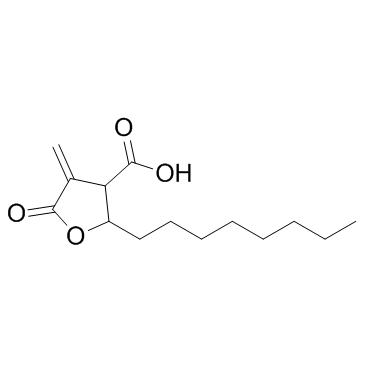C75

C75 structure
|
Common Name | C75 | ||
|---|---|---|---|---|
| CAS Number | 218137-86-1 | Molecular Weight | 254.322 | |
| Density | 1.1±0.1 g/cm3 | Boiling Point | 432.1±45.0 °C at 760 mmHg | |
| Molecular Formula | C14H22O4 | Melting Point | N/A | |
| MSDS | Chinese USA | Flash Point | 159.2±22.2 °C | |
Use of C75C75 is a synthetic fatty-acid synthase (FASN) inhibitor; inhibits prostate cancer cells PC3 with an IC50 of 35 μM. |
| Name | 3-carboxy-4-octyl-2-methylenebutyrolactone |
|---|---|
| Synonym | More Synonyms |
| Description | C75 is a synthetic fatty-acid synthase (FASN) inhibitor; inhibits prostate cancer cells PC3 with an IC50 of 35 μM. |
|---|---|
| Related Catalog | |
| Target |
IC50: 35 μM (PC3 cell)[1] |
| In Vitro | C75 inhibits PC3 cell growht with an IC50 of 35 μM at 24 h. C75 (10-50 μM) also reduces the growth of LNCaP spheroids in a concentration-dependent manner with an IC50 of 50 μM[1]. (-)-C75 inhibits FAS activity and has a cytotoxic effect on tumor cell lines, without affecting food consumption. (+)-C75 inhibits CPT1 and its administration produces anorexia, suggesting that central inhibition of CPT1 is essential for the anorectic effect of C75. The differential activity of C75 enantiomers may lead to the development of potential new specific drugs for cancer and obesity[2]. |
| In Vivo | C75 blocks fasting-induced c-Fos expression in the arcuate nucleus (Arc), lateral hypothalamic area (LHA), and paraventricular nucleus (PVN) 10–24 h after i.p. injection. Intraperitoneal administration of C75 at 30 mg/kg body weight inhibits food intake of mice by ≥95% within 2 h after i.p. injection[3]. C75-treated DIO mice has a 50% greater weight loss, and a 32.9% increased production of energy because of fatty acid oxidation. C75 treatment of rodent adipocytes and hepatocytes and human breast cancer cells increases fatty acid oxidation and ATP levels by increasing CPT-1 activity, even in the presence of elevated concentrations of malonyl-CoA[4]. |
| Cell Assay | Cells are seeded in 96-well plates and incubated for 2 days to allow exponential phase growth. Cells are then ished twice with PBS and treated with C75. After 24 or 48 h incubation, MTT is added to a final concentration of 0.5 mg/ml and cultures are incubated for 2 h. Cells are then solubilized with DMSO before measuring absorbance at 570 nm. Cell growth is also measured, using MTT assay, every 24 h up to 96 h[1]. |
| Animal Admin | Mice: C75 is administered either by i.p. (i.p.; 30 mg/kg of body weight) or i.c.v. (10 μg in 3 μL of RPMI medium 1640) injection. One, 11.5, and 24 h after i.p. injection, cumulative food intake is measured, mice are killed, brains are sectioned, and slices are subjected to immunohistochemical staining for c-Fos. All i.p. injections are given 1 h before the start of the dark cycle. For i.c.v. injection, mice are anesthetized with metofane and given 3 μl of RPMI medium 1640 (control) or C75 in RPMI medium 1640 into the lateral ventricle with a calibrated 10-μl Hamilton syringe[3]. |
| References |
[1]. Rae C, et al. Inhibition of Fatty Acid Synthase Sensitizes Prostate Cancer Cells to Radiotherapy. |
| Density | 1.1±0.1 g/cm3 |
|---|---|
| Boiling Point | 432.1±45.0 °C at 760 mmHg |
| Molecular Formula | C14H22O4 |
| Molecular Weight | 254.322 |
| Flash Point | 159.2±22.2 °C |
| Exact Mass | 254.151810 |
| PSA | 63.60000 |
| LogP | 3.65 |
| Vapour Pressure | 0.0±2.2 mmHg at 25°C |
| Index of Refraction | 1.489 |
| InChIKey | VCWLZDVWHQVAJU-UHFFFAOYSA-N |
| SMILES | C=C1C(=O)OC(CCCCCCCC)C1C(=O)O |
| Storage condition | 2-8℃ |
| Personal Protective Equipment | Eyeshields;Gloves;type N95 (US);type P1 (EN143) respirator filter |
|---|---|
| RIDADR | NONH for all modes of transport |
| WGK Germany | 3 |
| HS Code | 2932190090 |
| HS Code | 2932190090 |
|---|---|
| Summary | 2932190090 other compounds containing an unfused furan ring (whether or not hydrogenated) in the structure VAT:17.0% Tax rebate rate:9.0% Supervision conditions:none MFN tariff:6.5% General tariff:20.0% |
|
Acyl-CoA-binding domain containing 3 modulates NAD+ metabolism through activating poly(ADP-ribose) polymerase 1.
Biochem. J. 469 , 189-98, (2015) NAD(+) plays essential roles in cellular energy homoeostasis and redox state, functioning as a cofactor along the glycolysis and citric acid cycle pathways. Recent discoveries indicated that, through ... |
|
|
Saturated fatty acids modulate cell response to DNA damage: implication for their role in tumorigenesis.
PLoS ONE 3(6) , e2329, (2008) DNA damage triggers a network of signaling events that leads to cell cycle arrest or apoptosis. This DNA damage response acts as a mechanism to prevent cancer development. It has been reported that fa... |
|
|
EGFR signaling through an Akt-SREBP-1-dependent, rapamycin-resistant pathway sensitizes glioblastomas to antilipogenic therapy.
Sci. Signal. 2 , ra82, (2010) Glioblastoma, the most common malignant brain tumor, is among the most lethal and difficult cancers to treat. Although epidermal growth factor receptor (EGFR) mutations are frequent in glioblastoma, t... |
| 4-Methylene-2-octyl-5-oxotetrahydro-3-furancarboxylic acid |
| 4-Methylene-2-octyl-5-oxo-tetrahydro-furan-3-carboxylic acid |
| 4-Methylene-2-octyl-5-oxotetrahydrofuran-3-carboxylic acid |
| 3-Furancarboxylic acid, tetrahydro-4-methylene-2-octyl-5-oxo- |
| UNII:8E9A8CTX2H |
| C75 |